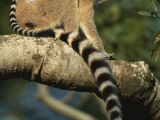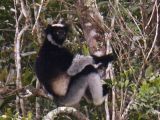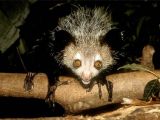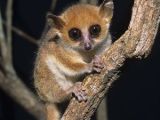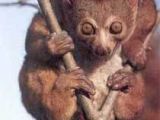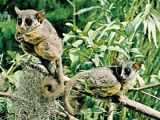1.These are monkeys before turning into real monkeys. 50 million years ago, the lemurs, our remote ancestors, were widespread, but clime changed and the emergence of the monkeys brought them to extinction. Some were saved in the island of Madagascar, which was just splitting from Africa. There were few mammals on the island, so the lemurs experienced an evolutionary boom there. In the present, there are about 45 species and subspecies of lemurs in Madagascar, but they are all endangered. Many other species disappeared from Madagascar.
Madagascar is the third island in the world as far as size is concerned, and it comprises habitats from deserts to rain forests. 5 clime areas are found, and the eastern coast is wetter than the western coast. Still, the dry forests have a varied lemur fauna.
2.Many lemurs are vegetarian. Brown lemurs eat a wide array of flowers, fruits and leaves. The collared lemur feeds mainly with fruits, while the indri mainly eat leaves coming from 80 species of plants (fact that makes it difficult to be kept in the captivity). The small nocturnal mouse lemur is insectivorous. When feeding itself, it holds the prey with its hands, lapping strongly the juicy parts. The aye-aye, even if insectivorous, also eats coconuts, thus attacking plantations. It extracts the white milk and flesh from the husks using its long median finger.
In fact, the aye-aye, living in the north and east coasts, feeds during the night with insects. It slightly beats the branches by using its enormous median finger, and it hears the rustle of the insects with its bat-like ears. The long bony finger evolved like a tool for extracting the food located under the bark of the trees. The aye-aye walks on its knuckles in order to avoid damaging its delicate tool.
Verreaux's sifaka, living in the spiny desert of southern and southwest Madagascar, can live without a water source, only licking the dew or using the moisture of the plants. This lemur has a body length of 43 cm (1.5 ft), while the tail is 53 cm (1.8 ft) long. The body weight is about 3.4 kg (7.5 pounds). They make weird bipedal lateral jumps while moving on the ground, including mothers carrying their baby on the back. The jumps can be made even from a tree to another (and those desert trees are extremely spiny!). Still, the species is threatened by the disappearance of its habitat made by the spiny forests. The nocturnal dwarf lemurs can make jumps up to 5 m (16 ft) long.
3.Unlike monkeys, lemurs have a well developed smell (they communicate through smell) and vibrissae. All lemurs have scent glands, located on the forearms and shoulders, which they use for marking their territories. The ring-tailed lemur rubs the glands from its wrists by its long tail used as a perfumed baguette for spreading its scent. Fluttering the tail is a signal of aggression. Information about sex and rank are transmitted through the pheromones from the scent. During the mating season, male lemurs compete through smell, trying to capture the attention of the females.
The lemurs emit various calls. The brown lemurs have an alarm call like an "obscene laugh", while the mouse lemur chirps when disturbed and the sifaka emits a call resembling its name. The oddest sound is given out by the aye-aye: an alien noise in the middle of the night, resembling the sound of a tambourine. Instead, the indri has a melodious descending call emitted when defending its territory.
Some species, like the mouse lemurs, are solitary, but most species have a complex social life, the bases of our behavior. In the case of the ring-tailed lemur, hierarchy is dominated by females. While competing for the right of mating, males follow female groups. They always drink after the females and the young, so that in case of drought, they are the first to die. Sifakas live in large families of aunts and uncles in which aggression is extremely rare.
The mouse lemur has several offspring, but most lemurs have just one. In the case of brown lemurs, twins are frequent. At first, the offspring hangs on its mother belly, but after a while it rides her.
4.Until 2,000 years ago, the lemurs had Madagascar just for themselves, for 50 million years. Then, people from Africa and Indonesia arrived, and the destruction started. Lemurs did not fear humans, so that hunters killed easily larger species, the largest being as big as a human! At least 20 species disappeared because tribes of cattle raisers burned large forests to create pastures. This is still going on.
Cut and burn agriculture for the rice cultivation is still practiced in the wet forests. The soils of Madagascar are fragile and the erosion proved catastrophic. The booming human population increases the pressure on the lemur populations. Lemurs are still poached for food and illegal cuts continue, even if the legends and myths of many Malagasy tribes consider them to be spirits of the ancestors.
5.Related to the lemurs are the lorises, pottos, bush babies and agwantibos. They mostly live in the rain forests of Africa and southeastern Asia, but some bush babies have advanced in dry forests, gallery forests and savannas. The name 'bush babies' comes from their calls, resembling a whining of a human infant. All these prosimians have prehensile hands and are nocturnal. They have big eyes that allow them to see well in the sunset and at the moon light. The sight is stereoscopic, detecting distances well, and the developed smell helps them during the hunt. Slow loris (Nycticebus) can be only 20 cm (8 in) long, weighing around 300 g (0.6 pounds).
Bush babies are extremely agile, having long legs conceived for jumping and long Tails for balance. They can make 10 m (33 ft) in 10 seconds. The other species are slow, their behavior being part of the camouflage. They remain immobile when a danger emerges. The pottos have bony napes and hardened skin in the area, forming a "shield". When a predator attacks, the potto hides its head between its hands and hits the enemy. Moreover, pottos have an extremely powerful bite.
The prosimians eat tree sap, fruits and insects. Larger species tend to be vegetarian. Thick tailed bush babies and pottos search for larger preys, like reptiles, bird eggs and even birds, rodents and bats. The keen hearing allows the lesser bush babies (Galago) to locate their prey and even catch flying mosquitoes.
Female bush babies have a territory they share with their daughters. Male offspring are chased away once adolescent, and they join other males. While females have territories of 1-10 hectares (depending on the species), male bush babies have larger territories, comprising that of several females. Females are sedentary, while the males are much more vagrant. The dominant male must fight fiercely for the territory with the younger males, and usually they cannot keep their rank more than one year. The pottos and the lorises are less vocal.
Prosimians leave scent messages during their wanders. Bush babies wash their hands and feet in their own urine to leave a scent dire wherever they go. The scent marks delimit territories, but are also meant for socializing.
Prosimians make one offspring annually, and the mother leaves the young in a nest for its first days, while she's foraging. Later, the mother transports the young in her mouth, leaving it nearby while she's foraging. In dawn, the young is carried back to the nest, for spending the daylight sleeping. In two weeks, mother and young join the group of the females. Some bush babies (Otolemur, Euoticus) carry the young on their backs after being four weeks old.
Prosimians are sometimes kept as pets, but the main menace for them is the habitat loss.
6.The tarsiers (sometimes named ghost lemurs) are considered to make the transition between lemurs and the other prosimians to monkeys. 8 species are found in the islands of southeastern Asia, being there for over 40 million years. These lemurs have huge feet, twice the length of the body, which allows them to make impressive vertical jumps. The neck vertebrae allow them to rotate their head and look backward. They pull their arms and feet close to their body and push backward, using the long tufted tail as a rudder. A twist in the air allows them to land face forward.
The eyes are huge (each eye weighs more than the brain) and unlike in other prosimians (and like in monkeys), smell has lost any important role. Hearing too is sensitive. The phantom lemurs are most active at the sunset, and they feed on insects, but also frogs, crabs, fish and lizards. Males and females sing to each other, executing beautiful 'duets' on various voices.
7.Related to primates are the tree shrews. They are semiterrestrial and most have lateral eyes. The sensitive snout is used for digging in the leaf litter while searching for food. Butterflies are sometimes caught with the "hands". Only the pen-tailed tree shrew (Ptilocercus) is nocturnal and has stereoscopic sight, like primates.
The tree shrews live in pairs or small groups. They share the same tree hollow while resting, but hunt individually. The personal territory is about one hectare and is marked by scent signals, often drops of urine or feces. Branches and twigs are marked by the secretion of the sternal gland on the chest.
The blind, deaf and nude newborns are kept in a special nest, separated from the main nest. The offspring are milk fed 5-10 minutes at each two days. The milk is rich in proteins and fats. The offspring drink it till turning swollen and immobile. They go out of the nest by the age of one month and are sexually mature by the age of 4 months.
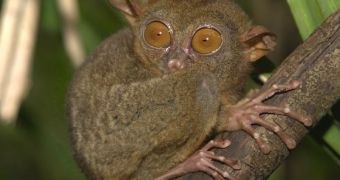
 14 DAY TRIAL //
14 DAY TRIAL // 
